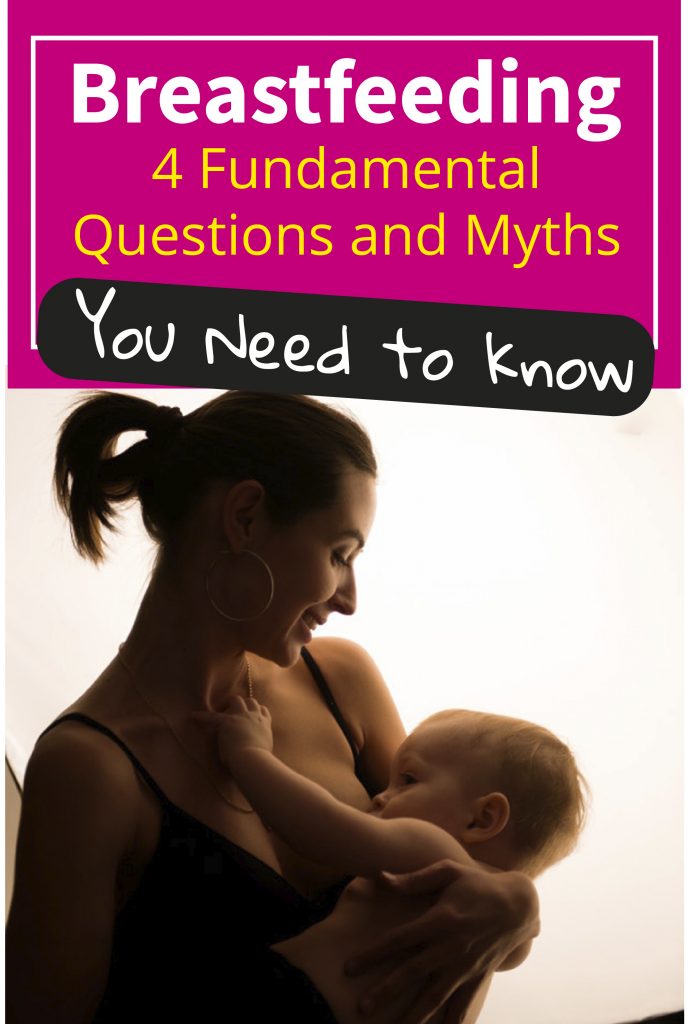
Breastfeeding is much more than nurturing a child. It is a process of deep interaction between mother and child. The nursing woman protects her baby from infections. Breastfeeding contributes to the cognitive and emotional development of the baby. Breastfeeding is one of the most important phases of the baby’s life and mothers should be attentive and seek to ask questions that may occur on a daily basis, even for mothers who have had children. Hygiene and health care, both mother and baby, should be observed either in feeding, in nipple care, hygiene, medications and many other factors that may concern mothers. The following are some recurring doubts, especially among mothers with their first child
1. It is not normal to experience pain when breast-feeding
Feeling very sore and bruised nipples is not normal and requires intervention. Some of the problems women face in breastfeeding, especially at first, are nipple cracks and mastitis.
Breastfeeding generates numerous benefits for mother and child. In addition to the nutritional value for babies, breast milk protects children from infections, allergies, some chronic diseases and childhood cancers. For the mother, breastfeeding reduces weight faster after delivery, helps the uterus recover normal size, decreases the risk of bleeding and anemia, and reduces the risk of diabetes and the development of breast and ovarian cancer.
There are many benefits generated by breastfeeding, however, some mothers may have difficulties when breastfeeding and need guidance support. At the beginning of the feedings, it is common for a woman to experience mild or even moderate pain in her nipples – due to the strong sucking of babies – and the areola. This pain can be considered normal and should not persist beyond the first week.
However, feeling the nipples very sore and bruised is not normal and requires intervention. Some of the most common problems women face, especially at the beginning of breastfeeding, are nipple cracks and mastitis.
What is mastitis?
It is an inflammatory process that occurs in the mammary glands, which may or may not evolve into a bacterial infection. Mastitis occurs more frequently in the second and third weeks after delivery, but can happen in any period of breastfeeding.
Three factors favor the installation of infection: accumulated milk, inflammatory response and chest injury. Nipple lesions are most often the gateway to the bacteria. Insufficient sucking of milk by the baby, obstruction of breast ducts, stress, fatigue and fissure in nipples can influence the appearance of mastitis.
It is not always easy to distinguish infectious mastitis from non-infectious only by signs and symptoms. In both, the affected part of the breast is sore, red and hot. When there is infection, there is usually malaise, high fever (above 38ºC) and chills. Look for a health unit if you have any of these symptoms for diagnosis and treatment.
What favors the appearance of mastitis?
- Breastfeds with regular schedules;
- Sudden reduction in the number of feedings;
- Long period of sleep of the baby at night;
- Use of pacifiers or bottles;
- Non-emptying of breasts;
- Excessive milk production;
- Separation between mother and baby;
- Abrupt weaning.
These factors favor the accumulation of breast milk in the breasts and predispose to the appearance of mastitis.
Who has mastitis has to stop breastfeeding?
Not. Proper emptying of the breast is important in the treatment of mastitis. Preferably, the breast should be emptied by the baby itself. Despite the presence of bacteria in breast milk, when there is mastitis, breastfeeding is indicated because it does not offer risks to healthy newborns. If after feeding there was no adequate emptying, it will be necessary to manually remove the milk. The most serious cases, when there is secretion and pus, should be diagnosed and treated as indicated by the health professional. Remember that self-medication can hurt the mother and baby.
How to prevent the breast spout from being cracked during breastfeeding?
Fissures can be a sign that it is necessary to improve the position of the baby. It’s good to seek help in the health service.
Check out some tips to prevent this from happening:
- The baby properly picks up the breast.
- The position of the baby is correct.
- Wash nipples with water only, do not use soaps, creams or ointments.
- It is not necessary to wash the nipples whenever the baby is breastfeeding.
- Remove some of the milk to soften the areola (dark part of the breast) before the breast feed if the breast is too full and hardened.
What is translactation?
It is a technique widely used, mainly in cases of premature babies, who do not have enough strength to suck breast milk or who needed to stay in incubators in the hospital.
Translactation is done with the use of a container, and may be a cup containing milk (preferably pasteurized human milk), placed between the mother’s breasts and connected to the nipple by means of a probe. The child, when sucking the nipple, receives the supplement. In this way the baby continues to stimulate the breast and feels gratified by sucking the mother’s breast and being sated.
The benefits associated with breastfeeding can be seen during the child’s development, even after weaning, such as the prevention of obesity in childhood and adolescence and the emotional socio-development of the child.
2. How to make safe use of medicines during breastfeeding

Can I take guilt-free medicine? Will my son be harmed? What should I avoid? Health professional guidance is essential for mother and baby health
The use of medications during breastfeeding is surrounded by fears. Women who take medications from chronic diseases, for example, can breastfeed, but always with the guidance of a health professional.
One of the common doubts among nursing mothers is whether they can take medications. Especially mothers who have chronic diseases such as diabetes and hypertension. Although most medications are compatible with breastfeeding, their use should be carefully evaluated by a health professional to avoid risks for mothers and babies. Few are formally contraindicated.
Breastfeeding is fundamental and of total importance. Therefore, it is important that women talk to a health professional to make a careful selection of what they use, so that they can breastfeed safely. But there are times when it is necessary to consider the risk/benefit of treatment in the nursing mother.
It is necessary to evaluate what kind of medicine the woman is taking. If it is a medicine that harms breastfeeding, it is necessary to analyze what has the highest value at the moment, the drug or breastfeeding, always remembering that breast milk is the best food for the baby.
Most medicines pass to breast milk, but in small amounts. Often, they are not absorbed in the child’s gastrointestinal tract. However, it is essential that the mother informs about the use of medicines. There are three categories of medications during the lactation period: compatible use, judicious use and contraindicated use. Therefore, the orientation of a professional is always important.
Continuous medicine
The follow-up and specialized orientation, from prenatal care, are essential for the woman who makes use of continuous medication to feel safe to continue their treatment during breastfeeding. Women who have chronic diseases can breastfeed, but in all these cases it is extremely important that this woman, since pregnancy, has been followed up, especially to feel supported at all times.
This follow-up was fundamental for nutritionist Sabrinna Scotton to continue breastfeeding her son. With diabetes since she was 11, she says that her profession has also helped her understand about it and therefore felt safe in taking her medications. “My insulin doses increased during pregnancy, but only in pregnancy. In the period of breastfeeding, I returned to normal dosage. But I knew this wouldn’t be a problem during breastfeeding, that It wouldn’t pass on to my daughter,” she says.
For more safety, even with those headaches in the rush of everyday life, discomfort, sickness or pain, it is important to always continue counting on medical advice in need of the use of any remedy and thus avoid risks to mom and baby. Moreover, when there is indication, the mother should use how prescribed, taking the right amount, at the right time, for the time it was determined.
3. I started breastfeeding. And now, how do I feed myself?
A good mother’s diet is very important during this period. After all, breast milk is the most complete food and indicated for the growth and development of the baby.
During pregnancy and after the birth of the child, every new mother, listens to various advice on what can or not eat, what foods increase milk production, what type of food can cause colic in the baby, among other tips. With Thays Martins, orthodontist and first-time mother, it was no different. “I’ve always been quite afraid because I’d hear a lot about the baby colic. So I tried to read and guide myself with a nutritionist and know what I could avoid so my son wouldn’t suffer,” he says.
See more: Colic in Babies – How to Treat and Cope With Colic |What to do to Prevent Colic in Babies
Also: Understand what GH is and how it acts on the child’s growth
Before cutting everything out of food because of the advice he heard, Thays sought professional help. “I was instructing to continue with my usual diet, but that was just to avoid some foods that could bother my baby. I only avoid a lot of food, but I don’t stop eating, just more selective,” thays says.
Breastfeeding is recommended exclusively up to six months and complementarily up to two years or more of the child’s life. A good mother’s diet is very important during this period. After all, breast milk is the most complete food and indicated for the growth and development of the baby.
Balanced feeding
The mother should have a balanced diet, with the appropriate amount of calories, including in her daily meal vegetables, fruits, milk, meats, in addition to the consumption of at least 2 liters of water per day. The mother should not take out the foods she is used to eating because she is breastfeeding. What she should do is observe whether the child has colic or trouble after breastfeeding. If this happens, she should remember what foods she consumed at the last meal and reduce the amount of suspicious food the next time she has access.
Colic are common in the first months of life because of the immaturity of the baby’s gastrointestinal tract. Therefore, it is not necessary to restrict any food from the mother’s eating routine. This is an adaptation process, it is natural for the child to have colic, because the gastrointestinal tract is still in formation. The child needs to go through this adaptation process, of course if the baby feels discomfort when the mother ingests a certain food, it is necessary to reduce and in some cases withdraw from the diet. Only the day-to-day between the mother and baby will point out the foods she should reduce consumption or even withdraw for a period.
The orientation is that the mother has a healthy diet, with many fruits, vegetables, protein, calcium and always try to have a balanced diet, as it is fundamental for the recovery of the mother and the success of breastfeeding.
- Tips for good feeding during breastfeeding:
- Eat natural food and avoid industrialized
- Look for a nutritionist
- Don’t worry about losing weight
- •Drink plenty of liquid
- Sleep well
- Do not stay too long without eating
Increased production and weight loss
The concern to return to pre-gestational weight and maintain good feeding for the child is also common. The woman needs to eat well and not worry about weight. With breastfeeding naturally the mother will lose weight and nourish her child, so no restrictive diet is indicated. During the lactation period the mother’s energetic needs increase and an average of 500 kcal is needed more per day in the first 6 months to cover caloric expenditure for breast milk production.
4. Know some myths that may hinder breastfeeding
Even if the benefits of breast milk and breastfeeding for mother and baby are proven, there are many myths that involve this moment of life and that can be a hindrance for mothers to breastfeed.
Breastfeeding is much more than nurturing a child. It is a process of deep interaction between mother and child. The nursing woman protects her baby from infections. Breastfeeding contributes to the cognitive and emotional development of the baby.
Even if the benefits of breast milk and breastfeeding for mother and baby are proven, there are many myths that involve this moment of life and that can be a hindrance for mothers to breastfeed. The Lovely Moms has selected some misguided statements, constantly reproduced by people.
Check out the answers and help us disseminate information about breastfeeding so that more and more families can ensure the health of children and women during the initial period of life of the baby.
Myth or Truth: Can breast milk be weak to nourish the baby?
Myth. There is no weak breast milk. Breast milk has a similar composition for all nursing women and is the ideal food for the baby, being recommended until two years of life or more, being exclusively up to the 6th month of life.
Myth or Truth: Do I have to give both boobs at a time?
Myth. The time of each feeding should not be fixed, as the emptying of the breast may vary depending on the baby’s hunger, from the interval between one breast and another, of the volume of milk stored in the breast, among others. The important thing is that the mother gives the baby enough time to properly empty her breast if she empties a breast altogether and the child still wishes to breastfeed, the mother can offer the other breast. Next time, it is recommended that the mother give the breast that was not offered in the previous breast feed or offer what the baby breastfed last.
Myth or Truth: Does frozen milk, even if taken from the breasts, do not have the same nutrients?
Myth. Milk can be frozen for up to fifteen days without losing its characteristics and nutritional quality as long as stored properly.
Myth or Truth: Who has made breast reduction or placed silicone cannot breastfeed?
Myth. Breast surgery does not prevent women from breastfeeding, as long the surgery keeps breast structures preserved.
Myth or Truth: Is it true that moms with small breasts produce less milk?
Myth. Breast size is unrelated to milk production. Both large and small breasts have the ability to produce the same volume of milk in one day. When it comes to breastfeeding, bigger isn’t better. Breast size is irrelevant.
Myth or Truth: Should nipples be sanitized every time the baby is breastfeeding?
Myth. It is not necessary to sanitize the breasts whenever it is breastfeeding; however it is important that the mother has adequate hygiene habits such as daily bathing, washing the breast with water and soap and always with a clean and dry bra.
Myth or Truth: Can breastfeeding during a second pregnancy impair the development of the baby in the womb?
Myth. It is possible to maintain breastfeeding in a new pregnancy if it is the desire of the woman and if there are no complications in pregnancy. However, when there is a threat of premature delivery, it may be indicated to interrupt. The hormone that controls milk ejection, oxytocin, also stimulates the uterus to contract. However, this hormone alone is not able to start delivery. The uterus is in the process of carrying the baby, well protected against an early delivery.
VITAMIN A: Essential fuel to ensure the proper functioning of the body
Babies up to six months of life can find vitamin A in breast milk. With the introduction of food, for children over six months, in addition to milk, vitamin A can be found in cooked bovine liver, raw carrot, among others.
We already know that the human body relies on a lot of vitamins to work well. However, most of them are not produced by our body. For children, vitamins are the fuel that ensures physical, cerebral and motor development to reach adulthood. Among the many letters of vitamins we need, such as vitamin A.
Those with vitamin A deficiency may have complications in the eyes, such as changes in the retina, conjunctiva and cornea, causing reduced sensitivity to light to partial or total blindness. In addition, low vitamin concentrations can increase the occurrence of health problems such as diarrhea and respiratory diseases.
Where we find vitamin A
Babies up to six months of life can find vitamin A in breast milk. With the introduction of food, for children over six months, in addition to milk, vitamin can be found in cooked bovine liver, raw carrot, mango, acerola, boiled pumpkin, melon, boiled egg, boiled broccoli, boiled spinach, whole cow’s milk, sautéed cabbage, papaya papaya papaya, arugula, guava, boiled carrot, lettuce, watercress and tomato, among others.
In practice, vitamin A is in animal foods, green leafy vegetables, yellow vegetables, and orange-yellow fruits.

Related content: breastfeeding classes near me, how to stop breastfeeding without getting mastitis, food to avoid while breastfeeding, best foods for breastfeeding, sore boobs breastfeeding, itchy nipples breastfeeding
Disclaimer: This post may have affiliate links.


